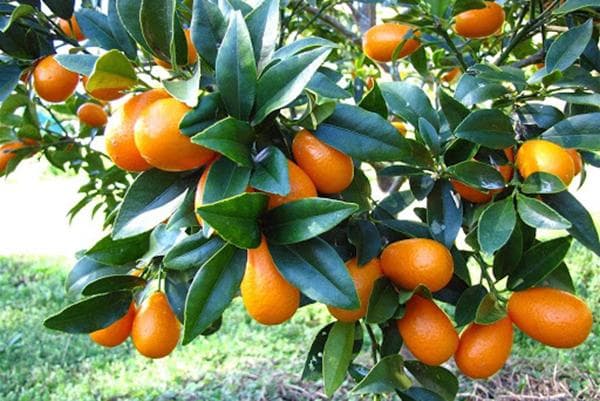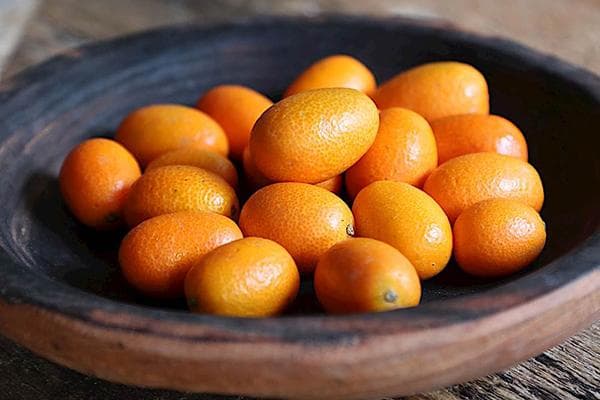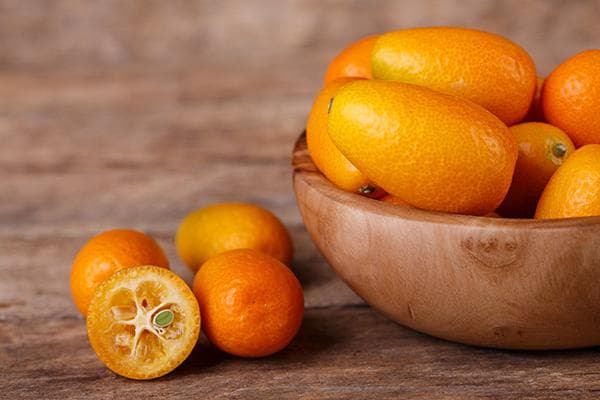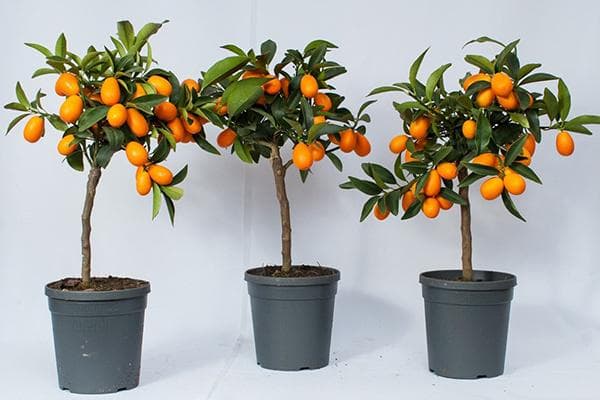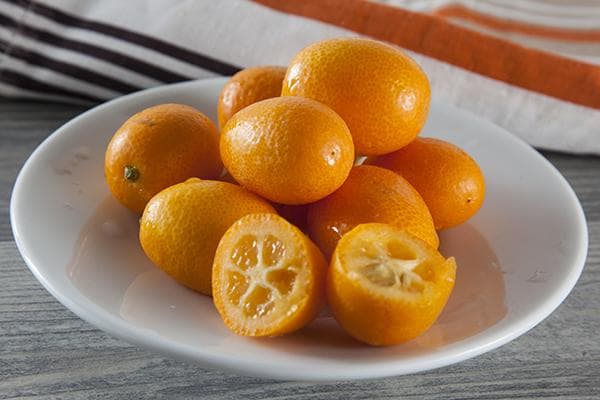What do men eat for hangovers and women for beauty? The benefits and harms of kumquat
Content:
Kumquat means "golden orange" in Cantonese. This fruit is popular among men due to its ability to eliminate hangover syndrome. Citrus helps women maintain beauty and prolongs youth, and children simply cheer up. Nowadays, kumquats can be bought in large supermarkets, health food stores, or grown at home yourself. We will tell you how this exotic fruit is useful and how to eat it correctly.
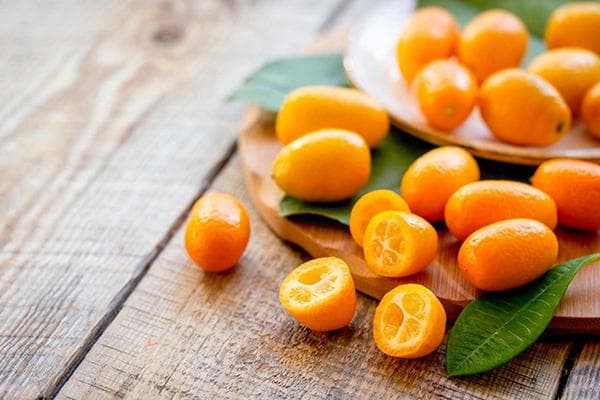
Kumquat - what kind of fruit is it?
Kumquat fruits grow on shrubs of the Citrus genus, Rutaceae family. They resemble plums in shape: oval and oblong. They reach no more than 2–3 cm in diameter. The color of the peel varies from golden yellow to orange-red.
The following varieties of citrus can most often be found on sale:
- Hong Kong (the smallest and juiciest);
- Malay;
- marumi;
- nagami;
- Nordmann;
- fukushi;
- Maeva.
The taste of kumquat is sweet and sour, with tart notes. Reminiscent of a mixture of orange and lemon, but with a more pronounced aroma.
Where does kumquat grow?
China is considered the birthplace of the kumquat. The fruit has also been growing for a long time in the countries of South Asia: Taiwan, Thailand, India, Japan, Indonesia, and the Philippines.
The kumquat was brought to Europe by the horticulturist collector Robert Fortun in 1846. Thanks to this man, the fruit received the botanical name Fortunella.
Nowadays kumquat is cultivated not only in Asia, but also in the following regions:
- Southern Europe, in particular on the island of Corfu in Greece;
- southern US states, especially Florida;
- in Crimea;
- on the Black Sea coast of the Caucasus and Abkhazia;
- Israel.
The fruit season begins in late autumn and ends in early March. During this period, fresh fruits can be found on sale.
The benefits and harms of kumquat for the body
The main benefits of kumquat are the same as other citrus fruits. But it also has unique medicinal properties, which were known about in ancient China.
Chemical composition and calorie content of fruits
Kumquat fruits have a low calorie content - only 70 kcal per 100 g. This means that they can be safely eaten by those who want to lose weight.
3 fruits contain half the daily requirement of vitamin C. This is a powerful natural antioxidant that protects the body from cancer, slows down the aging process and increases the elasticity of blood vessels.
The following compounds are also present in citrus pulp:
- vitamin B2 – strengthens the immune system and normalizes metabolism;
- vitamin B5 – reduces the risk of atherosclerosis, protects mucous membranes from damage;
- folic acid – prevents intrauterine pathologies of the fetus, reduces menstrual pain;
- potassium – normalizes blood pressure;
- magnesium – strengthens the heart, prevents muscle cramps;
- calcium – participates in the formation of bone tissue, reduces inflammation in the body;
- iron – reduces the risk of anemia.
If we analyze the chemical composition of kumquat, we can come to the conclusion that the fruit is especially useful for people with heart problems, women, and the elderly. And citrus peel is rich in essential oils that have antibacterial properties.
Medicinal properties of kumquat
In Chinese folk medicine, kumquat fruit has long been used to treat bacterial and fungal infections. The therapeutic effect is due to the presence of an active component in the fruits - furakumarin.
It is useful to eat fresh fruit if you have the following health problems:
- sore throat;
- dry cough;
- purulent wounds;
- high cholesterol;
- hypertension;
- weak immunity;
- vitamin deficiency;
- anemia;
- tendency to constipation.
The essential oils present in kumquat peel are good for toning the psyche and helping a person cope with mental stress. Therefore, the fruits are useful for office workers, as well as schoolchildren and students to eat while preparing for exams.
Harm and contraindications
Kumquat can cause the same harm to the body as other citrus fruits. For example, cause allergies or food intolerances. You should not overuse fruits to avoid getting an overdose of vitamins.
The fruit is contraindicated in case of increased acidity of gastric juice, gastritis, ulcers and acute inflammatory processes in the kidneys. Diabetics should use kumquat with caution due to the high sugar content in the fruit.
What are the benefits of dried kumquat?
Dried kumquat retains almost all the chemical compounds found in fresh fruit. If, of course, it was stored correctly.
Doctors recommend eating dried fruit if you have the following health problems:
- chronic constipation;
- vitamin deficiency;
- liver and blood diseases.
However, it is important to take into account the high calorie content of dried fruits: 230–350 kcal per 100 g.
Why do dried kumquats come in different colors?
Nowadays you can find dried fruits of different colors on sale: yellow, orange, red and even green. Real dried kumquat has a nondescript pale yellow color. This is the product that will bring maximum health benefits.
The remaining colors are a result of the use of dyes. Although in rare cases, the green color indicates that you bought a hybrid kumquat variety.
How to eat kumquat?
It is correct to eat kumquat with the peel. It contains most of the nutrients. The peel also tastes sweet, while the flesh is sour. Naturally, the fruit should be thoroughly rinsed under running water before consumption. It is then eaten like an apple or cut into thin rings.
Kumquat can be added to fish, poultry, and meat when stewing or baking. Small citrus fruits go especially well with pork: they remove excess fat and add juiciness and a piquant aroma to the finished dish. The fruit is also used to make desserts:
- jam and jam;
- marmalade and jelly;
- candied fruits
Kumquat peel is used to flavor alcoholic drinks, especially strong ones: whiskey and cognac. It gives them a delightful citrus trail.
How to grow kumquat from seed?
Growing a kumquat from a seed is not difficult, but the same cannot be said about caring for it. This is a rather finicky plant that needs warmth, good lighting and careful watering. Citrus begins to bear fruit only in the 10th year after planting.But until this moment, the kumquat will delight you with glossy green leaves and beautiful blooms.
To grow a citrus tree, proceed as follows:
- Prepare a pot with a diameter of at least 8 cm. The deeper the container, the taller the plant will grow.
- Place a layer of drainage at the bottom of the pot. Then fill in a mixture of fertile soil and river sand.
- Use seeds obtained from fresh fruit for planting. The seeds should be dried first. It is also advisable to soak the seeds in a nutrient solution (for example, Zircon, Novosil) before sowing.
- Moisten the soil. Plant the seeds to a depth of 2–3 cm. Cover the pot with plastic wrap and place in a warm place.
The first kumquat shoots will appear in about 1.5 months. In winter, the plant should be kept in direct sunlight at a temperature of at least 15–17 degrees. In summer, diffuse lighting is more suitable. When the seedlings become large, they will need to be planted in different pots.
So, kumquat is a healthy and very tasty fruit. It is worthy of adding to the collection of your favorite citrus fruits. It is advisable to eat the fruit fresh. It will charge you with vitamins during the cold season and lift your spirits.
